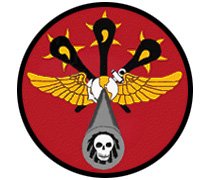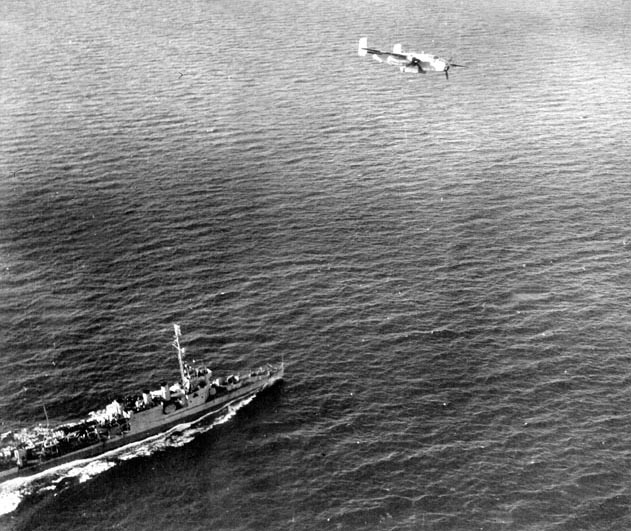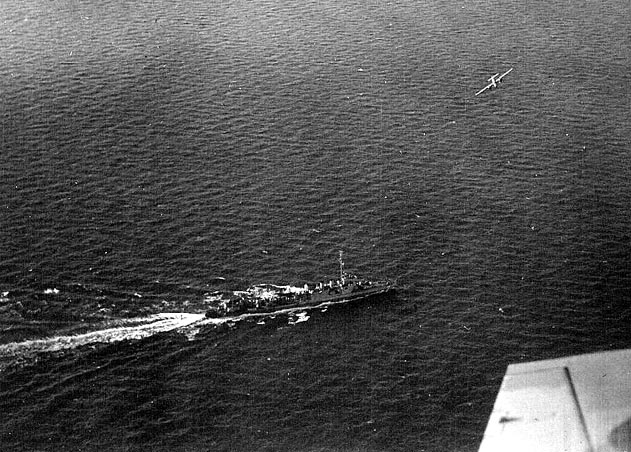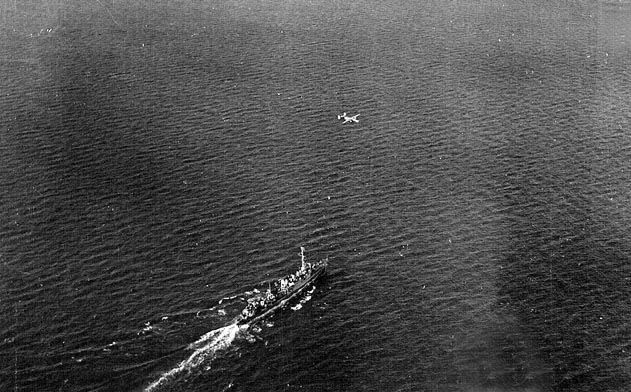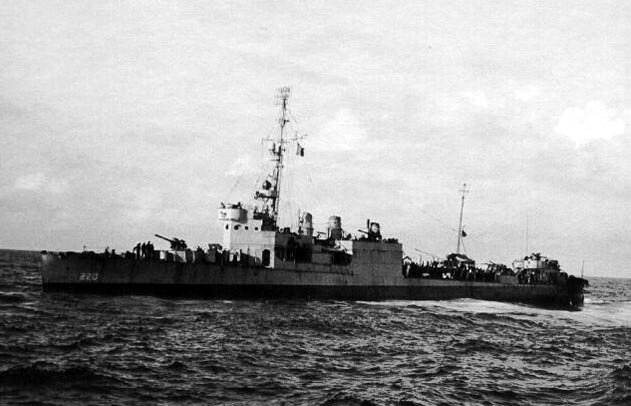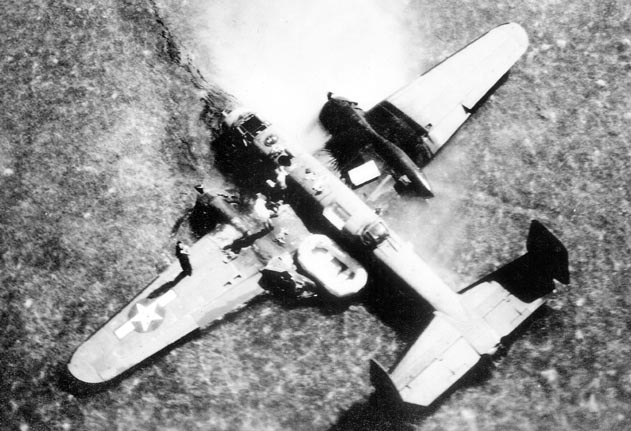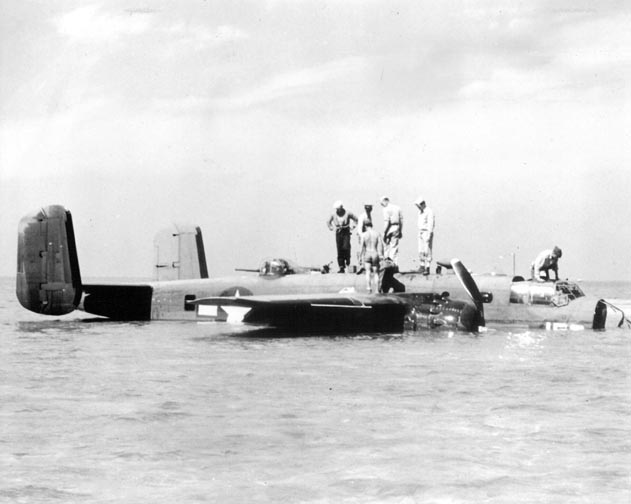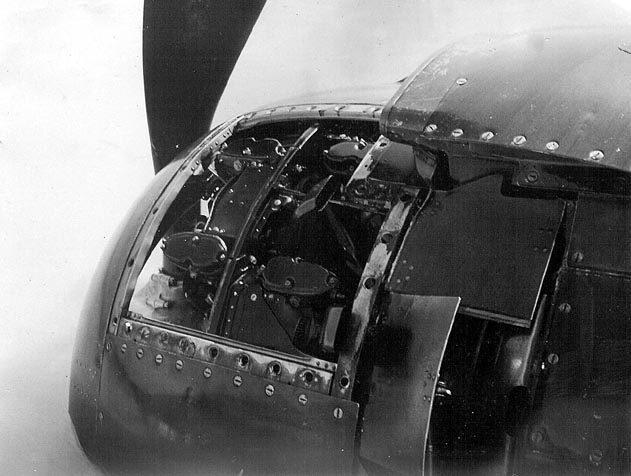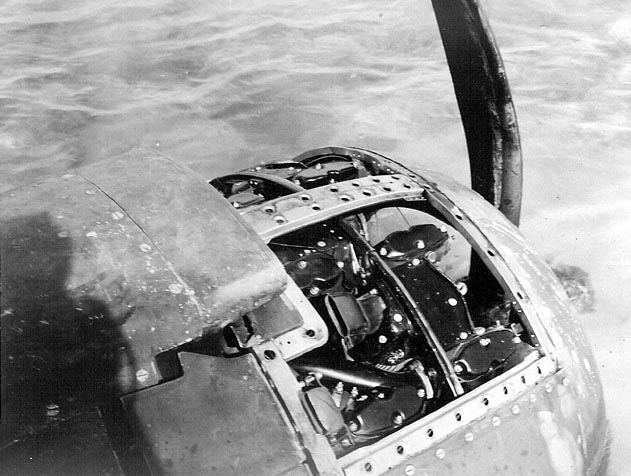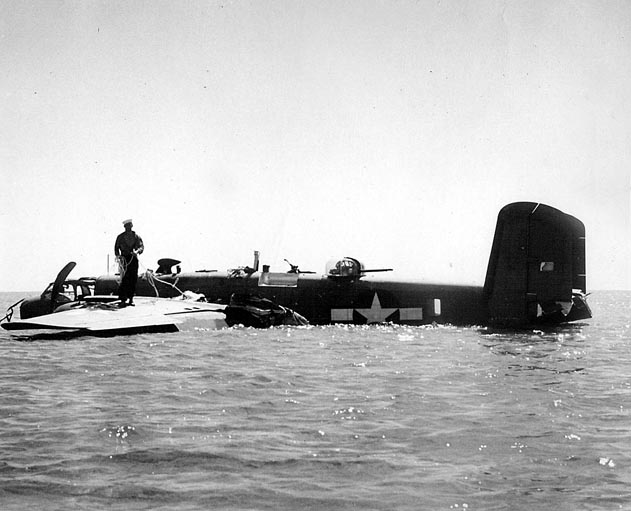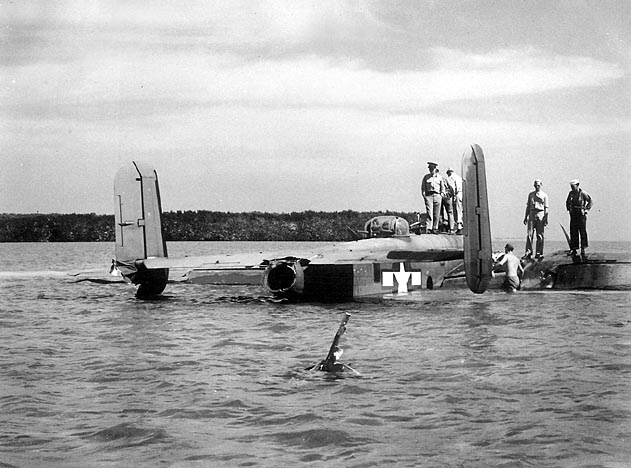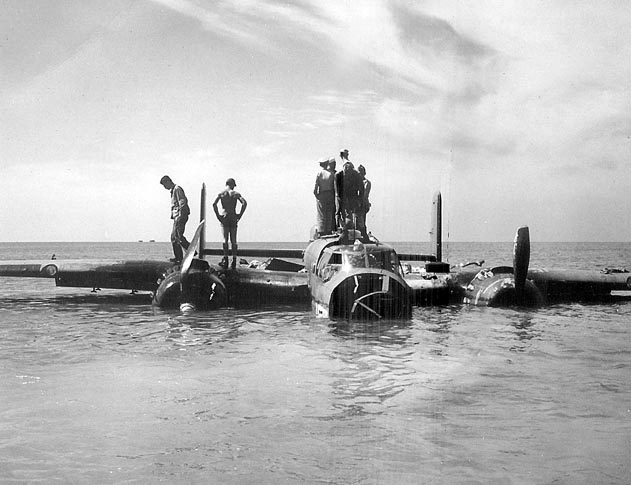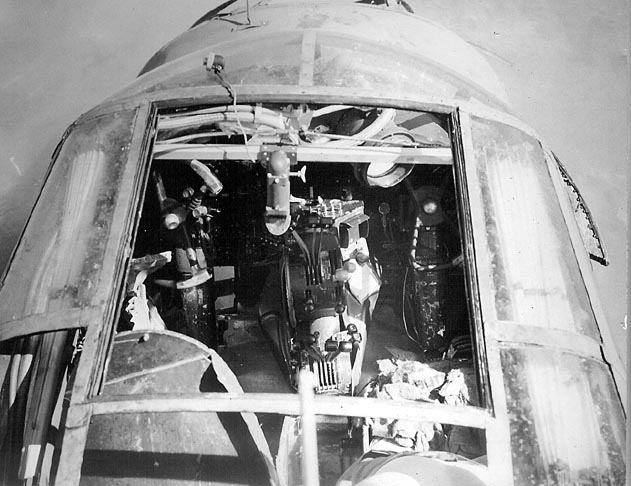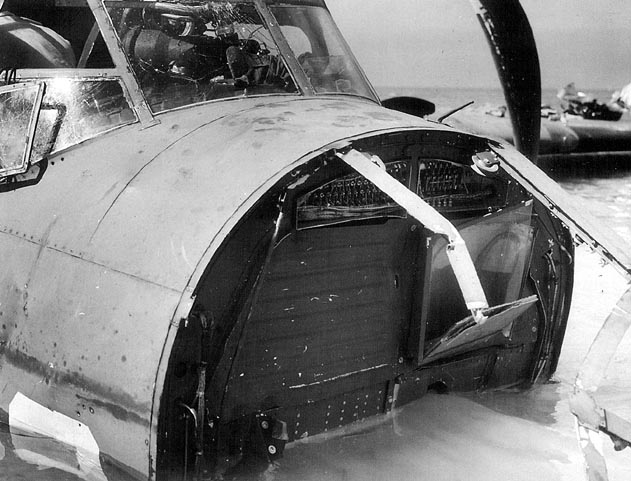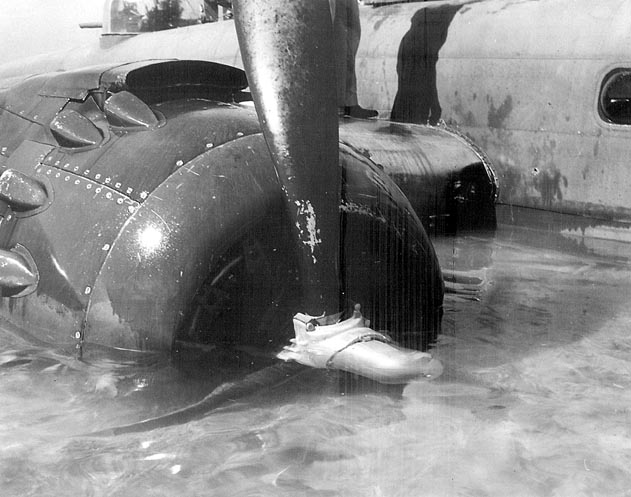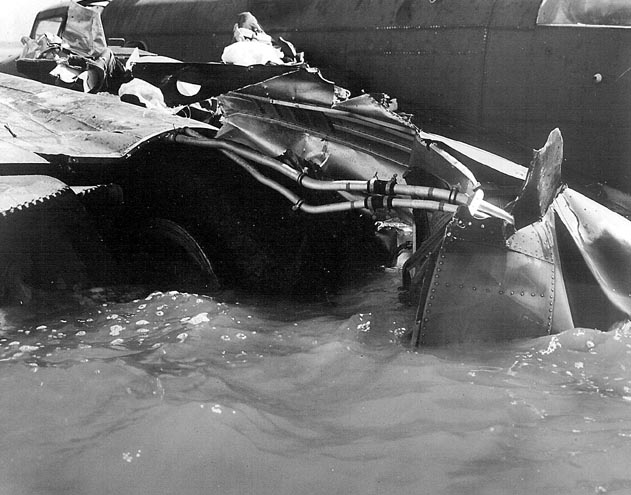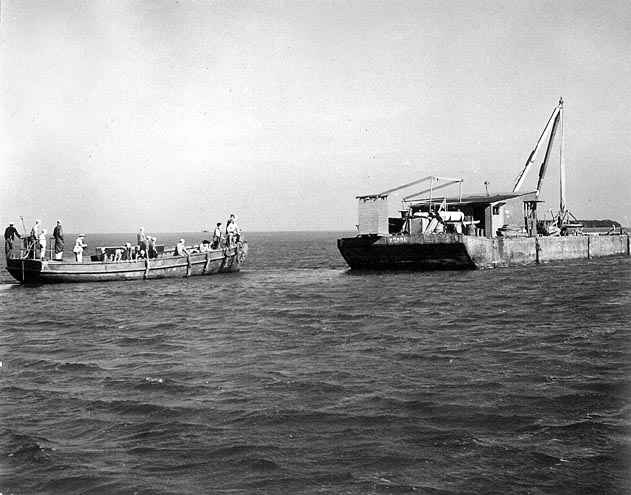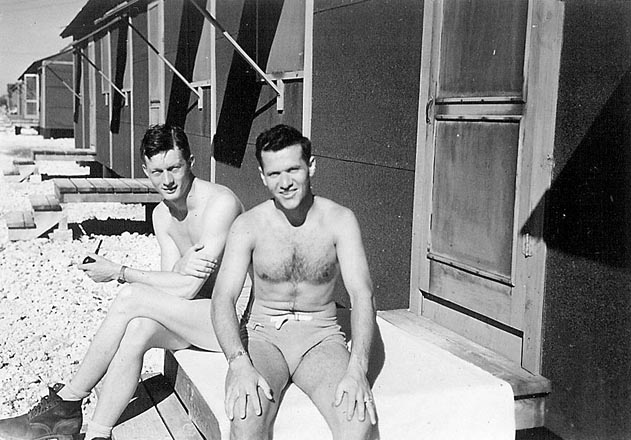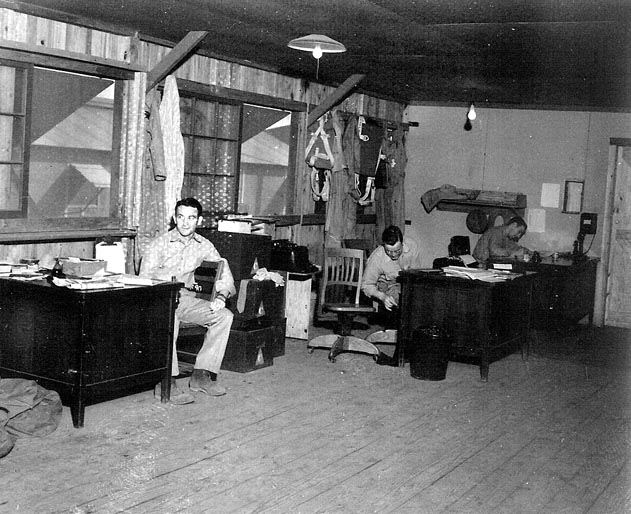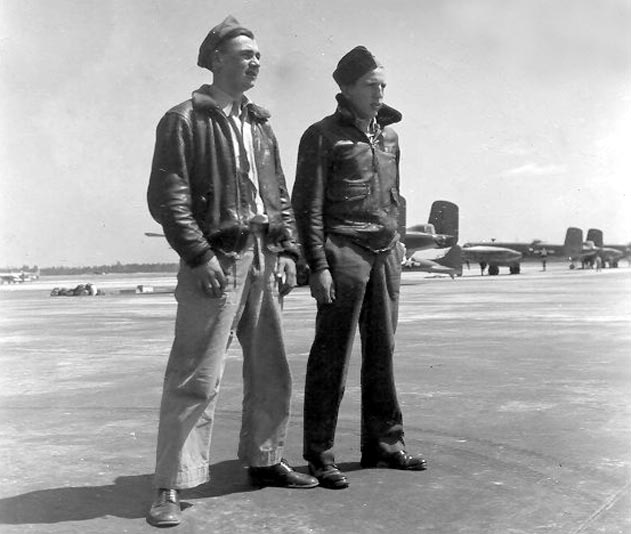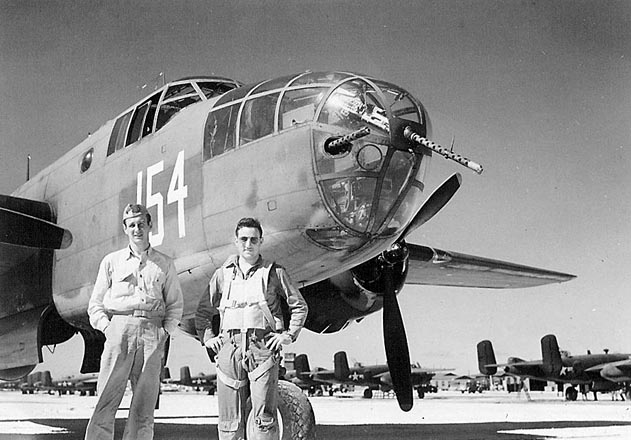|
|
||
|
|
||
|
|
TRAINING AT NAS BOCA CHICA: PAGE 1 At NAS Boca Chica, a line area was set up, and offices were opened in a small building acquired from the Navy. Flying immediately commenced with familiarization hops, and after more lectures on dropping the aerial torpedo, simulated torpedo runs with 2,000 pound concrete dummy torpedoes. On February 29, 1944, while making one of these runs on the target vessel, the USS MacLeish, Major Baker's aircraft (BuNo 35047) developed a runaway propeller. Major Baker immediately headed back to the airfield and attempted to salvo his 2,000 pound dummy in order to maintain altitude. When all attempts to do so failed, he was forced to make a water landing eight miles west of Key West. Although Major Baker made a "textbook" landing in 18 inches of water, he broke both legs and suffered severe facial lacerations in the landing. The co-pilot and radioman, having suffered only minor injuries, were able to pull Major Baker onto the aircraft's wing where they were rescued by a Navy crash-boat. As a result of his injuries, Major Baker was transported to the Naval Hospital at Key West, Florida where he remained recuperating for many months. In light of Major Baker's injuries, Major Nevils immediately assumed duties as commanding officer, and Major Danser as assumed duties as executive officer. Additional personnel changes included the assignment of Captain Richard C. O'Reilly, USMCR, of Los Angeles, California, who had just transferred into the squadron, as operations officer, and the detachment and reassignment to MAG-61 of Captain Woten who had served as assistant operations officer. As well as simulated bombing and strafing runs, live torpedo runs at a target ship were conducted once the pilots had become proficient dropping the concrete dummy torpedoes. Additionally, numerous navigation hops to various parts of the United States and Cuba were performed with many hours of night and instrument flying being logged as the aircraft remained in the air daily from 5:00AM to 10:00PM. Further practice in anti-shipping tactics included strafing and dropping live bombs at towed targets. During this time, each pilot also spent one day aboard the target destroyer observing and assessing the squadron's tactics. Since arriving at NAS Boca Chica three weeks earlier, the squadron had flown 1,141 sorties with a total of 2,357 flight-hours. Despite this extremely high operational tempo, all elements of the squadron performed well and only two minor incidents resulted. The first incident occurred on the 6th, when a "wheels-up" landing was made by of one of the squadron's pilots when he discovered he had no indicated air speed due to his failure to remove the cover on the aircraft's pitot tube. With no crew injuries and only minimal damage, this aircraft (BuNo 35159) was quickly repaired and was operational by the end of the day. The second incident occurred when the wingtip of one of the squadron's taxiing PBJ-1s struck and damaged the Plexiglas on the nose of a another aircraft. This too resulted in no injuries and only minor damage that was quickly repaired. Following this grueling schedule, all officers and men enjoyed liberty while at NAS Boca Chica. Liberty was much better than that at MCAS Cherry Point, as Key West and Miami, Florida, and Havana, Cuba were readily accessible. As VMB-613 completed their training at NAS Boca Chica and prepared to return to MCAS Cherry Point, morale was high and the squadron's readiness percentage was at 72.43.
TORPEDO RUN: A PBJ-1D of VMB-613 flies over a Navy destroyer on a practice torpedo or bombing run as evidenced by the open bomb bay doors. The destroyer is believed to the the USS Dahlgren (DD-187), and old World War I era flush-deck destroyer. The USS Dahlgren was remodeled and refitted in 1938. As part of that process, the fourth funnel was removed. Photograph: U.S. Marine Corps (Courtesy of William A. Kehr)
BAD RUN: At an altitude of 300 feet, this PBJs torpedo run was considered poor as he turned before crossing the bow of the target vessel. The photo aircraft, whose wing can be seen to the lower right was a TBM. Photograph: U.S. Marine Corps, Arthur H. Navarre Collection (Courtesy of Diane Hindy)
GOOD RUN: At an altitude of 350 feet, the pilot of this aircraft made a good run on the target vessel. Torpedo runs required leading the target 1 1/2 times the ships length at the target's estimated speed of 16 knots. Photograph: U.S. Marine Corps, Arthur H. Navarre Collection (Courtesy of Diane Hindy)
USS MACLEISH: The USS MacLeish (DD-220) served as a target vessel for VMB-613 while training at NAS Boca Chica. While conducting a simulated torpedo attack on this ship on February 29, 1944, Major Baker's aircraft developed mechanical problems which resulted in the aircraft being ditched near Key West, Florida Photograph: U.S. Navy Historical Archives
MAJOR BAKER DOWN: An aerial view of Major Baker's PBJ-1C following his successful water landing near Key West, Florida. Note that the life raft has been deployed. The lack of major structural damage serves as evidence to Major Baker's skill as a pilot. Photograph: U.S. Marine Corps (Courtesy of Charles F. Knapp)
DITCHED PBJ: Major Baker's PBJ-1C (BuNo 35047) following his successful water landing near Key West, Florida. The landing occurred on February 29, 1944 after his aircraft developed a runaway propeller and he was unable to jettison a 2,000 pound dummy torpedo. Although both of Major Baker's legs were broken in the landing, the other two crew members sustained only minor injuries. Photograph: U.S. Marine Corps (Courtesy of William A. Kehr)
PORT ENGINE: Access panels to the port engine were removed in an effort to determine the cause of the aircraft's loss. Photograph: U.S. Marine Corps, Arthur H. Navarre Collection (Courtesy of Diane Hindy)
PORT ENGINE: Inboard view of the port engine following the removal of the engine access panels. The cause of this accident was determined to have been a runaway propeller rather than engine failure. Photograph: U.S. Marine Corps, Arthur H. Navarre Collection (Courtesy of Diane Hindy)
SALVAGE WORK: A Navy salvage man walks across the port wing prior to the salvage of the aircraft. Note the opened life raft compartment just aft of the wing. Photograph: U.S. Marine Corps, Arthur H. Navarre Collection (Courtesy of Diane Hindy)
SALVAGE TEAM: A Navy salvage team inspects the damage to Major Baker's aircraft. Photograph: U.S. Marine Corps, Arthur H. Navarre Collection (Courtesy of Diane Hindy)
AWAITING SALVAGE BARGE: The salvage team awaits the arrival of the salvage barge which can be seen in the distance. Photograph: U.S. Marine Corps, Arthur H. Navarre Collection (Courtesy of Diane Hindy)
COCKPIT: Damage to the cockpit was minimal although Major Baker broke both legs in the emergency landing. Major Baker was pulled through the escape hatch in the canopy by his copilot, First Lieutenant Eugene L. Amber. Photograph: U.S. Marine Corps, Arthur H. Navarre Collection (Courtesy of Diane Hindy)
BOMBARDIER'S STATION: A close-up reveals damage to the bombardier's station of Major Baker's ditched PBJ. Photograph: U.S. Marine Corps, Arthur H. Navarre Collection (Courtesy of Diane Hindy)
STARBOARD ENGINE: Although submerged in saltwater, no visible damage is apparent to the starboard engine of Major Baker's PBJ. Photograph: U.S. Marine Corps, Arthur H. Navarre Collection (Courtesy of Diane Hindy)
PORT SIDE DAMAGE: Major Baker's emergency landing resulted in severe structural damage to the port wing and engine nacelle when it struck a coral outcropping. Photograph: U.S. Marine Corps, Arthur H. Navarre Collection (Courtesy of Diane Hindy)
SALVAGE BOAT: A U.S. Navy crash boat and salvage barge arrives on the scene of Major Baker's emergency landing. Photograph: U.S. Marine Corps, Arthur H. Navarre Collection (Courtesy of Diane Hindy)
RELAXING: First Lieutenants Robert S. Ligon and Richard D. Newton relax outside of their quarters at Boca Chica. Photograph: U.S. Marine Corps, Arthur H. Navarre Collection (Courtesy of Diane Hindy)
SQUADRON OFFICE: Marines working in the squadron's office at NAS Boca Chica. Photograph: U.S. Marine Corps, Arthur H. Navarre Collection (Courtesy of Diane Hindy)
ON THE FLIGHT LINE: Standing on the flight line at NAS Boca Chica in their M-422A leather jackets, Staff Sergeant James J. DeBoth and Private First Class Jack S. Lowder observe the squadron's activities. In the background, three PBJ-1Ds and the tail of and SBD can be seen. Photograph: ©2006 Robert DeBoth
MB-154: First Lieutenants Richard D. Newton and Gordon I. Fied on the flight line at Boca Chica. The aircraft is a D-model PBJ, Bureau Number 35154. Photograph: U.S. Marine Corps, Arthur H. Navarre Collection (Courtesy of Diane Hindy) |
|
|
Copyright © 2008 Marine Bombing Squadron Six-Thirteen Association. All Rights Reserved. |
||
